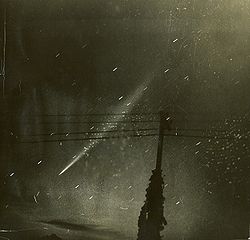astro.wikisort.org - Comet
Comet Ikeya–Seki, formally designated C/1965 S1, 1965 VIII, and 1965f, was a long-period comet discovered independently by Kaoru Ikeya and Tsutomu Seki. First observed as a faint telescopic object on September 18, 1965, the first calculations of its orbit suggested that on October 21, it would pass just 450,000 km above the Sun's surface, and would probably become extremely bright.
- There are two comets named Ikeya–Seki: C/1965 S1 (this one), and C/1967 Y1, a.k.a. 1968 I, 1967n.
 | |
| Discovery | |
|---|---|
| Discovered by | Kaoru Ikeya, and Tsutomu Seki |
| Discovery date | September 18, 1965 |
| Alternative designations | Great Comet of 1965, 1965 VIII, 1965f |
| Orbital characteristics A | |
| Epoch | October 7, 1965 |
| Aphelion | 183.192214 (A) and 207.40555533 (B) AU |
| Perihelion | 0.007786 (A) and 0.007778 (B) AU |
| Semi-major axis | 91.6000000 (A) and 103.7066667 (B) AU |
| Eccentricity | 0.999915 (A) and 0.999925 (B) |
| Orbital period | 876.7008 (A) and 1056.1320 (B) years |
| Inclination | 141.8642°(A) and 141.861°(B) |
| Last perihelion | October 21, 1965 |
Comets can defy such predictions, but Ikeya–Seki performed as expected. As it approached perihelion observers reported that it was clearly visible in the daytime sky next to the Sun. In Japan, where it reached perihelion at local noon, it was seen shining at magnitude −10.[1] It proved to be one of the brightest comets seen in the last thousand years, and is sometimes known as the Great Comet of 1965.
The comet was seen to break into three pieces just before its perihelion passage. The three pieces continued in almost identical orbits, and the comet re-appeared in the morning sky in late October, showing a very bright tail. By early 1966, it had faded from view as it receded into the outer Solar System.
Ikeya–Seki is a member of the Kreutz sungrazers, which are suggested to be fragments of a large comet which broke up in 1106.
Gallery
- Comet Ikeya–Seki, seen from Canberra, 31 October 1965. Drawing by David Nicholls.
- Comet Ikeya–Seki, 30 October 1965. Photo by James W. Young (TMO/JPL/NASA)
Notes
- Brightest comets seen since 1935 Archived December 28, 2011, at the Wayback Machine
References
- C/1965 S1-A at the JPL Small-Body Database
- C/1965 S1-B at the JPL Small-Body Database
External links
![]() Media related to Comet Ikeya-Seki at Wikimedia Commons
Media related to Comet Ikeya-Seki at Wikimedia Commons
На других языках
[de] C/1965 S1 (Ikeya-Seki)
C/1965 S1 (Ikeya-Seki) (jap. 池谷・関彗星 Ikeya-Seki-suisei) war ein Komet, der im Jahr 1965 auch am Tage mit dem bloßen Auge gesehen werden konnte. Er war der hellste Komet des 20. Jahrhunderts und wird aufgrund seiner außerordentlichen Helligkeit zu den „Großen Kometen“ gezählt.- [en] Comet Ikeya–Seki
[es] Cometa Ikeya-Seki
El cometa Ikeya Seki (C/1965 S1) fue descubierto independientemente por los astrónomos aficionados Kaoru Ikeya y Tsutomu Seki, con unos 15 minutos de diferencia de uno a otro, el 18 de septiembre de 1965, a las 19h12m, al oeste de la estrella "Alphard" (α Hydrae) con una magnitud estimada de 8, presentándose difuso con condensación. El 19 de septiembre a las 18h57m36s lo confirmaba el Smithsonian Astrophysical Observatory desde Woomera (Australia). Desde un primer momento se le reconoce como un cometa "suicida" o de Kreutz, aumentando su brillo rápidamente. Así el 1 de octubre tuvo una magnitud aproximada de 5,5 y el día 12 del mismo mes, de 2; y una cola de unos cinco grados de longitud. Pasó por el perihelio a 0,007786 u.a. del Sol el 21 de octubre de 1965 a las 4h24m, pudiéndose ser visto en pleno día, tapando con la mano el disco solar. En ese momento pudo tener una magnitud de —10 o —11.[2] La cola del cometa alcanzó una longitud de 20 a 25 grados en los últimos días de octubre y primeros de noviembre. En su afelio se aleja del astro rey hasta 183,192214 u. a. Su periodo de revolución es de 876,684262 años. Existe una posibilidad de que este cometa fuese el retorno del gran cometa X/1106 C1, que fue visto en plena luz del día en toda Europa.-[ru] C/1965 S1 (Икэя — Сэки)
Комета Икэя — Сэки, C/1965 S1 (Ikeya — Seki) — долгопериодическая комета, которую независимо друг от друга открыли японские наблюдатели Каору Икэя и Цутому Сэки. Впервые наблюдалась 18 сентября 1965 года как слабый телескопический объект. Первые вычисления её орбиты показали, что 21 октября она пройдёт на расстоянии всего около 450 тыс. км над поверхностью Солнца и, возможно, станет чрезвычайно яркой.Другой контент может иметь иную лицензию. Перед использованием материалов сайта WikiSort.org внимательно изучите правила лицензирования конкретных элементов наполнения сайта.
WikiSort.org - проект по пересортировке и дополнению контента Википедии



